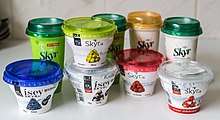Skyr


Skyr (Icelandic pronunciation: [ˈscɪːr̥], English: /ˈskɪər/ SKEER) is an Icelandic cultured dairy product.[1] It has the consistency of strained yogurt, but a milder flavor.[1] Skyr is technically classified as cheese, although widely regarded as yogurt. It has been a part of Icelandic cuisine for centuries.[1][2]
Skyr has a slightly sour dairy flavor, with a hint of residual sweetness.[1] It is traditionally served cold with milk and a topping of sugar. Commercial Icelandic manufacturers of skyr have added flavors such as vanilla or fruit to the final product to increase its appeal.[3]
History
Skyr was brought from Norway to Iceland centuries ago, and though the tradition died out in most of Scandinavia, it lived on in Icelandic culture, and parts of Norway. Skyr is mentioned in a number of medieval Icelandic sources, including Egil's saga and Grettis saga. It is unclear how similar this was to modern-day skyr, as no detailed descriptions of skyr exist from this period. Culinary historian Hallgerður Gísladóttir has suggested that skyr was known throughout Scandinavia at the time of the settlement of Iceland, but eventually forgotten outside of Iceland.[4]
In Norway today, the term "skyr" is also used for other variants of cultured milk products – usually byproducts from cheese production. In its traditional use, it was diluted with water when used as a beverage, or mixed with milk and crumbs of flatbread as a quick meal.[1]
Availability
Skyr is a popular product in Iceland. The largest brand of skyr in the world is the US-based siggi's, which is sold in over 25,000 US stores. Skyr has also gained popularity in the other Nordic countries. Thise Mejeri in Denmark has produced skyr since May 2007. A licensed version produced by Q-meieriene is available in Norway since 2009, Finland since 2010 and Sweden since 2011. Since 2015, "Icelandic-style skyr" has been produced by the Danish-Swedish cooperative Arla in Denmark, United Kingdom, Germany and the Netherlands. Other Danish producers of skyr include Løgismose and the small Bornholmian producer Ö Skyr. In Latvia, skyr is produced by Tukuma Piens under the brand Baltais. In Estonia, skyr has been sold since May 2016 under the brand Farmi by Farmi Piimatööstus. The President's Choice brand is available in the Netherlands and has been in Canada since 2015.
Since 2015, skyr has been made in Yorkshire, United Kingdom.[5] Icelandic skyr is marketed in Austria, Bulgaria, Ireland, Germany, Belgium, the Netherlands, Switzerland, Poland, Croatia, the Czech Republic, Nordic countries (including the Faroe Islands and Greenland), the Baltic states, Canada, Portugal, Italy, Slovenia, Iran, and Australia.
Nutrition
Skyr is a high protein, low-fat product (lowfat milk is used), varying slightly between brands. Unflavored skyr is roughly 12% protein, 3% carbohydrate, and 0.5% fat, while high in calcium and vitamins commonly found in milk products.
Uses
Skyr may be used in a traditional Icelandic dish called hræringur (meaning "stirred" or "made by stirring") which consists of roughly equal amounts of skyr and porridge. It is often mixed with jam or fruit for a dessert, with prepared fish for dinner, or with cereals for breakfast. Contemporary uses include using skyr as a cheesecake topping and as an ingredient in fruit smoothies.
Production
Traditionally, skyr is made with raw milk; however, modern skyr is made with pasteurized skimmed milk.[1] A small portion of skyr is added to the warm milk, to introduce the right bacteria, such as Streptococcus thermophilus and Lactobacillus delbrueckii subsp. bulgaricus. Rennet is sometimes added as well, and the milk is left to coagulate.[1] The skyr is then strained through fabric to remove the whey (mysa in Icelandic) and the milk solids retained.
According to many Icelanders and Icelandic skyr producers, the milk for skyr should be made by Icelandic cows and the skyr itself produced in Iceland using the original skyr cultures. Skyr, however, is also made in various other countries. The cows in Iceland are supposed to produce milk with five times more omega-3 fatty acids than milk from any other Nordic country according to MS Iceland Dairies.[6]
- Milk is separated from the cream.
- Skimmed milk is pasteurized.
- The pasteurized milk is fermented using a skyr culture for over eight hours. The skyr culture contains special yoghurt cultures and a small amount of rennet. Because rennet is used, it is considered a cheese and not a yoghurt.
- The fermented milk is then filtered.
- Additional steps may add such things as flavouring.
See also
- Filmjölk – another Nordic cultured milk product
References
- 1 2 3 4 5 6 7 "What is skyr?". Food-Info, Wageningen University, The Netherlands. 1 July 2017. Retrieved 25 June 2018.
- ↑ Guðmundur Guðmundsson. "Hnigfræði og smásæ bygging skyrs: Abstract" (in Icelandic and English). Archived from the original on 10 July 2012. Retrieved 25 April 2012.
- ↑ Kim Severson (14 September 2005). "Iceland woos America with lamb and skyr". New York Times. Retrieved 25 June 2018.
- ↑ Hallgerður Gísladóttir (1999). Íslensk matarhefð (in Icelandic). Reykjavík: Mál og menning. p. 73. ISBN 9979-3-1846-5.
- ↑ Brian Oliver (27 November 2016). "Welcome to skyr, the Viking 'superfood' waking up Britain Skyr". The Observer. Retrieved 25 June 2018.
- ↑ Erin Zimmer (2018). "Gallery: Iceland: Behind the Scenes Tour of a Skyr Factory". Serious Eats. Retrieved 25 June 2018.
| Wikimedia Commons has media related to Skyr. |
